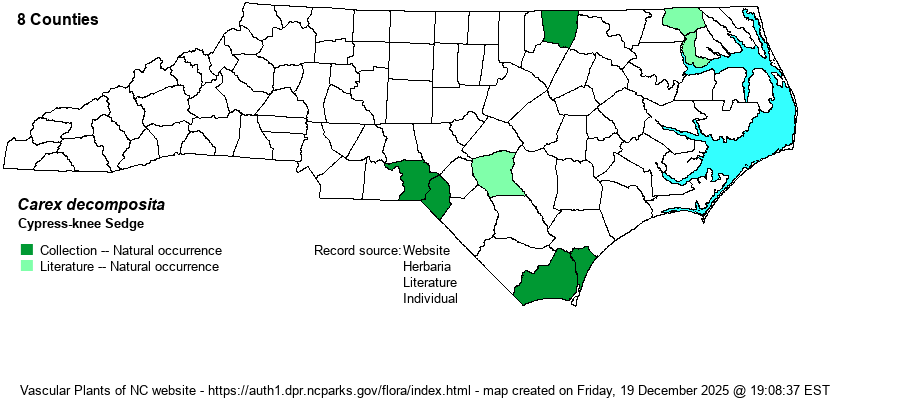| Author | Muhlenberg | |
| Distribution | Scattered in the Coastal Plain and lower Piedmont. The wide gaps between populations are no doubt real.
NY to MI south to northwestern FL and TX. | |
| Abundance | Very rare overall across the eastern 40% of the state, though where found, plants are uncommon to fairly common. This is a Significantly Rare species. | |
| Habitat | Beaver ponds, impoundments, river meander marshes, swamps with cypress and Swamp Tupelo (Nyssa biflora) -- in blackwater conditions. Often grows from lower trunks (at the waterline) and knees of cypress trees and on fallen trunks. | |
| Phenology | Flowering and fruiting late April-July, depending on water levels. | |
| Identification | Plants of Cypress-knee Sedge form large, dense tussocks with long flowering stems (culms) that arch outward. The branched inflorescence is distinctive, once learned. | |
| Taxonomic Comments | None
The genus Carex is the largest in North America, and among the largest in the world. In temperate and boreal regions, Carex is often the dominant or co-dominant ground layer in many habitats. Seeds (achenes) are valuable food for birds and small mammals, while foliage is used by birds and mammals to make nests and as food by mammals. Species of Carex often look vastly different from one another -- spikes erect vs. drooping, tiny inflorescence vs. whopping, culms leafy vs. naked, perigynia beaked vs. beakless, stems densely bunched vs. single, etc. The genus has been divided into many sections (or groups), based on shared characters; some taxonomists have suggested that these be different genera, but that proves unworkable (so far). All Carex share the feature of a perigynium (an outer covering) which completely surrounds the achene (seed). This covering may fit tightly or loosely (like a small bladder), depending on which group or species. Details of perigynia shape, ornamentation, presence and size of beak, number of striations (or veins) are all important ID features. In recent years Rob Naczi and colleagues have stressed the importance of arrangement of perigynia -- whether spiral (3+ ranks) or distichous (2-ranked) -- and have named a number of new species as well as split off some older synonyms. Therefore, RAB's (1968) key, excellent for its time, can only be used in a general way today. Members of some sections of Carex are difficult to key out (notably Ovales, Laxiflorae, Griseae); this is in part due to variation among individuals of a species, or failings of the key. FNA has drawings of most species and some species may be found in two or more places within a key, to acount for variability. New species to NC, and new to science(!), continue to be found in NC. | |
| Other Common Name(s) | Decomposite Sedge, Epiphytic Sedge | |
| State Rank | S2 | |
| Global Rank | G3G4 | |
| State Status | SR-O | |
| US Status | | |
| USACE-agcp | OBL link |
| USACE-emp | OBL link |

